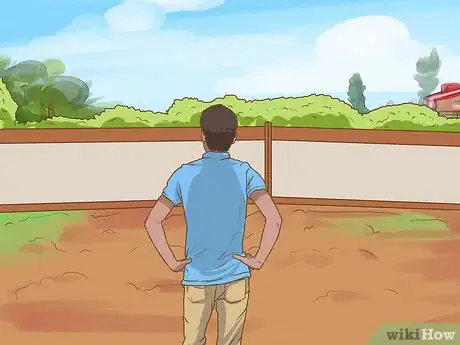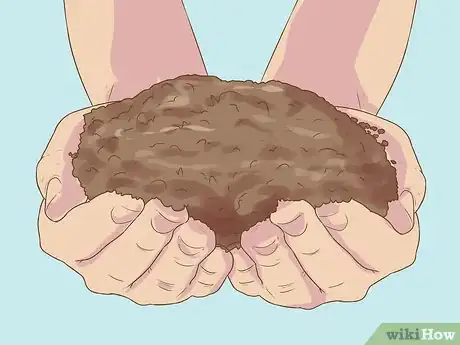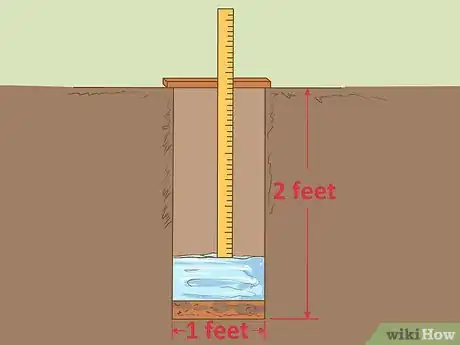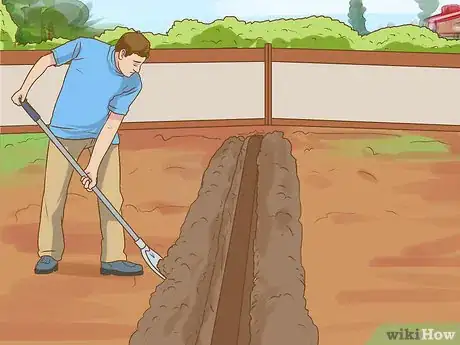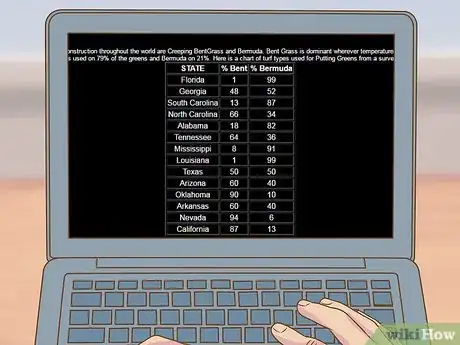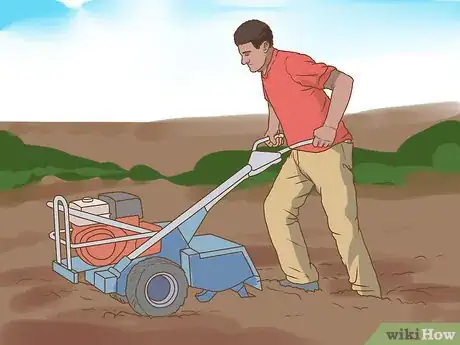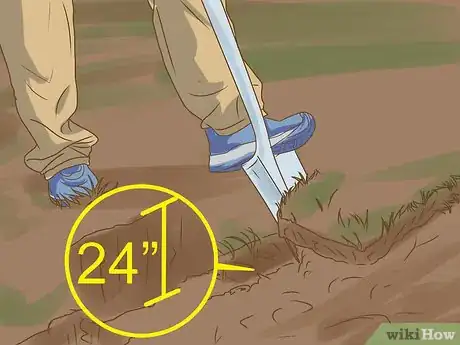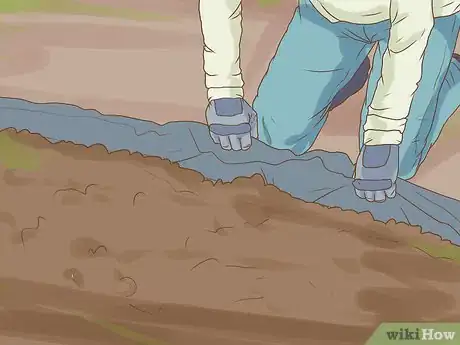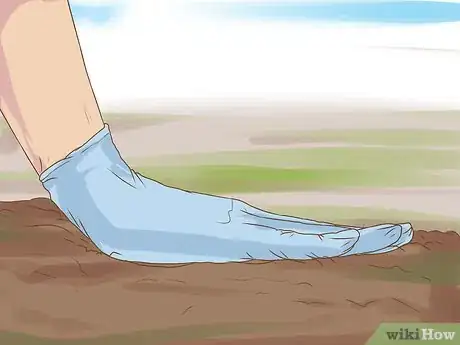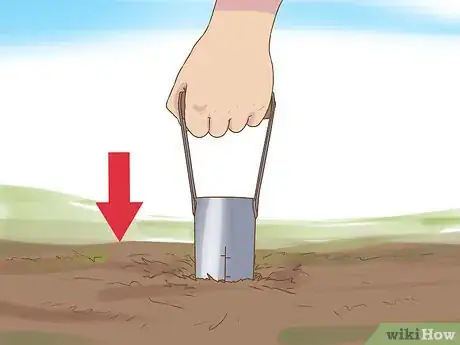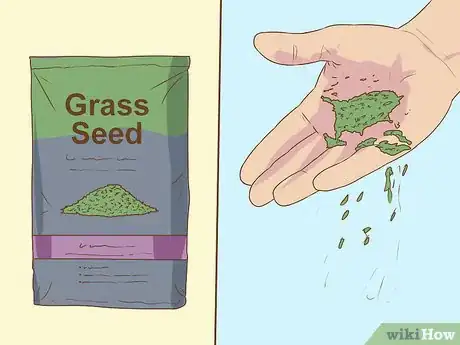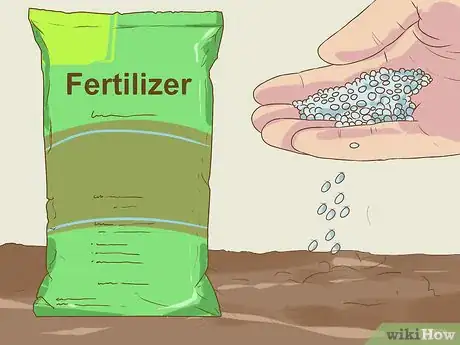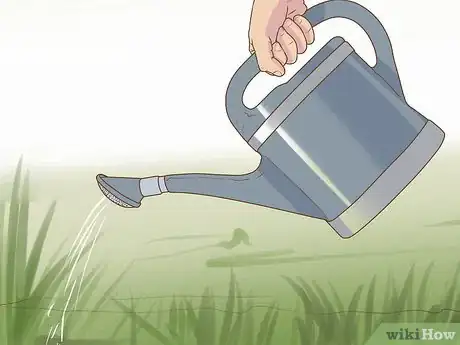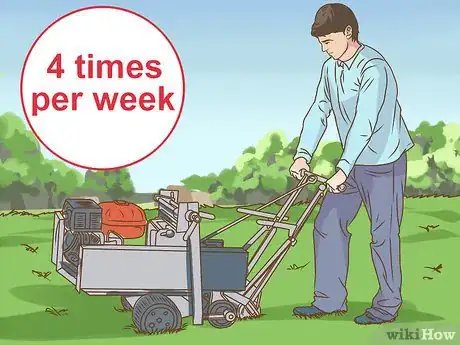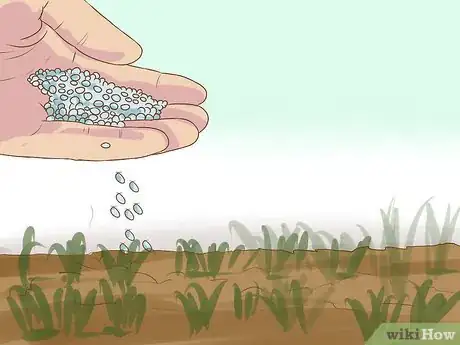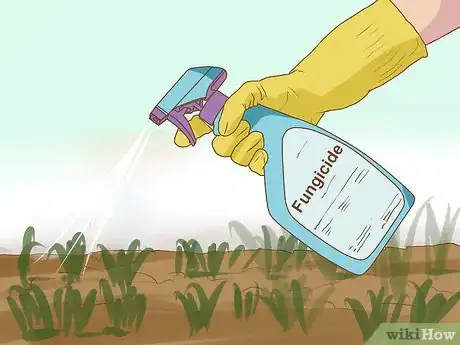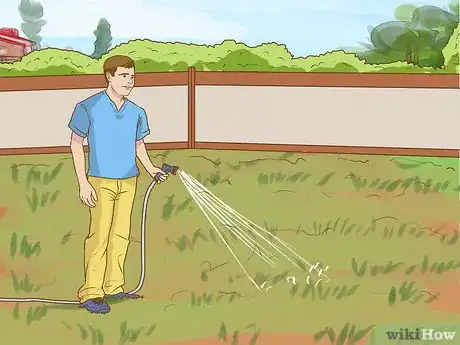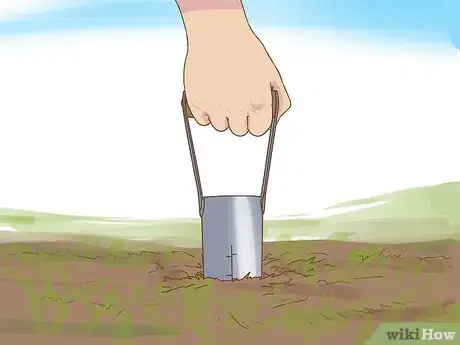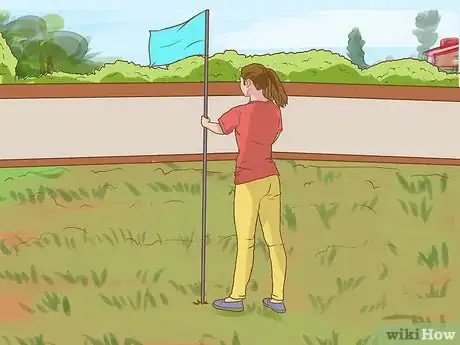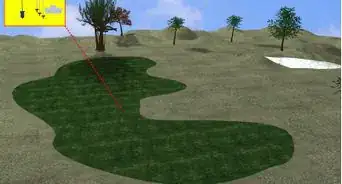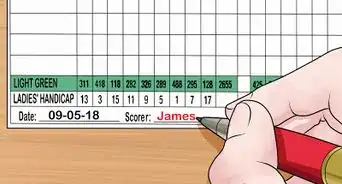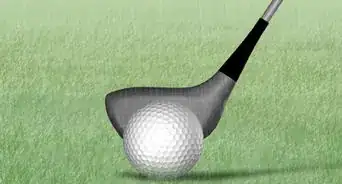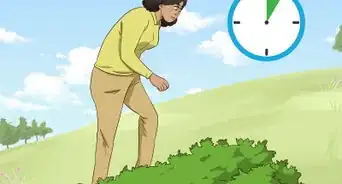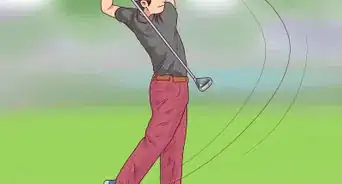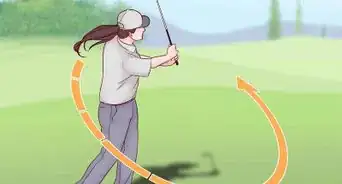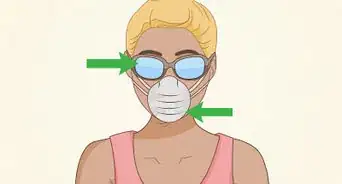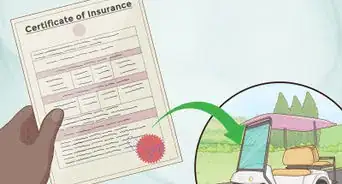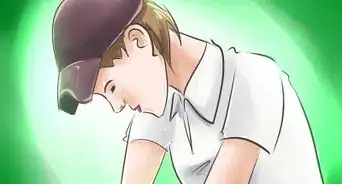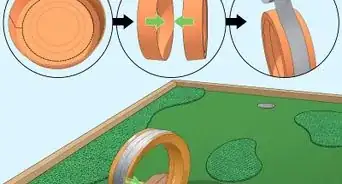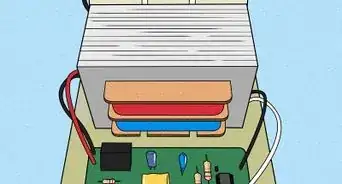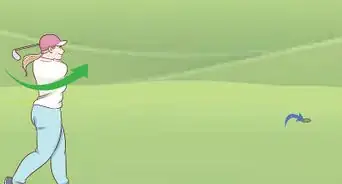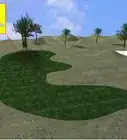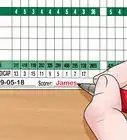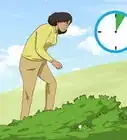wikiHow is a “wiki,” similar to Wikipedia, which means that many of our articles are co-written by multiple authors. To create this article, 14 people, some anonymous, worked to edit and improve it over time.
There are 7 references cited in this article, which can be found at the bottom of the page.
wikiHow marks an article as reader-approved once it receives enough positive feedback. In this case, 95% of readers who voted found the article helpful, earning it our reader-approved status.
This article has been viewed 295,366 times.
Learn more...
Having your own putting green in your backyard makes it easy to practice putting in your spare time. A real putting green will require money, extensive labor, and constant attention. Even with diligence, a real green in your backyard may pale in comparison with the ones you are familiar with on the links.[1] You'll need to choose the right location before anything else, then you can start designing the area and using the right nutrients. With the proper tools and materials, you can incorporate a putting green into your backyard's overall landscape and enjoy the recreational benefits.
Steps
Preparing to Make Your Green
-
1Choose your green location. You'll want your green to be located in an open area in your backyard that gets plenty of sunlight. Your future green should receive plenty of airflow, without any blockage of wind from buildings, bushes, or trees. Low spots in your backyard or areas that drain poorly should also be avoided, but after you've found the ideal place for your green, you should:[2]
- Imagine the overall dimensions for your green. After you have a feel for the features of your soon-to-be putting green, take a piece of paper and sketch out the general design, including desired measurements. Then, measure and stake out your planned putting green area.
- Keep in mind, the larger your green, the more effort it will take to maintain and the greater the cost of its installation.
-
2Evaluate your soil. For the turf of your green to flourish, its roots will need the right kind of soil. Most soils are suitable for the roots of your grass, though the ideal soil composition will be sandy loam soil. If your soil has a high concentration of clay, your turf will suffer greatly, and may not be able to grow well enough for you to putt.[3]Advertisement
-
3Perform a soil test to check for clay. A percolation test can give you a good idea of the whether your soil composition is good enough for the roots of your grass and is relatively easy to perform. You will need to dig a hole 2' deep with the width of about a foot. Now, fill your hole with water and allow it to drain over the course of a day. Then, note the time, and fill the hole with water again.
- Holes that drain in less than 12 hours have a rate of percolation that will support plants the require well-drained soil, which includes your putting green grass.
- Holes that drain in 12 - 24 hours are suited for plants that live in heavy or clay soil.
- Holes that drain in over 24 hours are unsuitable for most plants.
-
4Appraise your surface drainage. The contours of your green-to-be should allow water to drain quickly and easily, otherwise your green could fail. Low areas where water can collect will also bad for your green. Try to provide multiple drainage routes to keep the grass from becoming waterlogged.[4]
- You can improve drainage conditions by installing drainage tiles below the surface of your green. It is advised that you place these close together, at a maximum spacing distance of no more than 10 feet (3 m).[5]
-
5Research grass seed by region. There are two dominant types of grass used to build putting greens, Creeping Bentgrass and Bermuda. Depending on region, you may want to use one over the other, or you in certain areas, a hybrid might flourish. To check the distribution of Creeping Bentgrass and Bermuda according to state, visit:[6]
Constructing Your Green
-
1Ready the soil. You'll need to tear up any original sod where you plan to make your green. After sod removal, you should rake rocks and other debris to create optimal drainage, aeration, and seeding conditions.[7]
- Using a tiller for the soil will loosen and aerate the soil even more, promoting even better growth and soil consistency.
- Keep in mind that spring is the best time to plant a putting green.
-
2Add some drainage, if necessary. The best way to ensure that your putting area stays sufficiently drained is to install drainage tiles or vented plastic pipe. Dig a trenches that are roughly 24 inches (61 cm) deep and 12 inches wide, that lead from the edges of your green and through it, with the trench sloping downward away from your green leading water away from it. To install drainage, you should:
- Place filter fabric around the bottom of your trench so it reaches up the sides.
- Lay your perforated/vented plastic pipe in the trench.
- Fill your trench with 12 inches (30.5 cm) of coarse, clean gravel.
- Fold the ends of your filter fabric on top of your gravel.
- Refill the remainder of your trench with soil.[8]
-
3Separate your green to protect against weeds. An extra degree of separation can not only keep your putting green more weed free, it can also keep your yard from getting invaded with Bentgrass or Bermuda. Using a plastic lining is a good way to protect your green from your yard and your yard from your green.
-
4Smooth the soil. For your first attempt at making your own putting green, the easiest kind to make are mostly level. Low spots can ruin the quality of your grass, so you should spread soil evenly with your rake.[9]
- Keep about a yard of sand off to the side to fill in low spots, animal tracks, or any other unplanned changes to your green.
-
5Sink your putting hole. Using your bulb planter, create a hole slightly larger than a golf ball where you think would be best for you putting hole. This is just to give you an idea of the layout of your green; you will sculpt the hole and insert the putting cup later.
Planting and Maintaining Your Green
-
1Sow your grass seed. Mix some of your seed with your sand to offer it additional cover when you scatter it. This can be helpful if you have a bird problem, though if you notice birds feeding heavily on your seed, you may want to scatter extra. In principle, a pound of seed should cover about 2,000 square feet, though there will be some variance depending on the kind of grass on which you decide.
-
2Fertilize your seed. Depending on the kind of grass you have chosen to use for your green, there will be many different options of fertilizer you can use. You should research the fertilizer best suited for your seed by searching online.[10]
- Different types of grass will also have ideal times at which you should apply fertilizer. Research this information as well to see best results in your grass growth.
-
3Water your seed heavily. Newly sown grass is very thirsty, so you'll need to water your putting green heavily, twice daily. Many putting green designers also recommend syringing your green, especially in hot weather.[11]
- Syringing is where you lightly water turf to cool off your turf canopy and prevent wilt.
- If no complications arise, your turf should germinate in 10 days.
-
4Mow with a greens mower. The first cut of your putting green grass should be after the grass has exceed two inches in height. You will need to be careful when walking behind your greens mower. Walk with gentle, flat footed steps, as the top layer of your green will still be loose. As a good root system grows, the ground will firm up.
- Mow the putting green often. By cutting your grass 3 or 4 times per week, it will maintain a height of around ¼" - a perfect putting height.[12]
-
5Continue to fertilize. For every 1,000 square feet of yard space apply at least ½ pound of nitrogen to the soil between early May and early June. From mid-September to mid-November, use at least 1 pound of nitrogen.[13]
- You should also look into special fertilizer formulated for your type of grass and/or putting greens. Many companies have special blends of fertilizer. You'll need to research for yourself to find what works best for your situation.
-
6Apply fungicide monthly. This will also depend on the kind of grass you have decided and the area in which you live. Certain kinds of grass are more susceptible to certain kinds of mold, and some strains of mold might not live in your region.
- Generally, you should administer fungicide once every month.[14]
-
7Keep your green from wilting. At the first sign of dryness you should water your green to prevent it from sun damage. Apply water to the putting green during the early morning hours, such as between 5 and 7 a.m.
-
8Insert your putting cup, if desired. The small hole you dug for your putting hole may suffice for your needs, but installing a cup will give your green a more realistic feel. You can further sculpt your putting hole by using a jigsaw or a golf-hole cutter, and insert the cup.
- Your cup should sit a ½" below the grass level.
-
9Plant your flag. To complete the aesthetic, you can take the component flag that came with your putting cup and insert it into your cup. This is a good way of checking to see if your cup has been placed in the hole flush with the ground. An unlevel cup might mean your ball bounces out of the hole more frequently than it should.
Community Q&A
-
QuestionWhat is the ideal number of blades for a mower?
 Community AnswerThe more the better. Typical consumer mowers have 5 blades, which will work, but you will have to make more passes to get all the grass blades cut. This will cause more trauma to your turf. I suggest you get at least a 7 blade mower.
Community AnswerThe more the better. Typical consumer mowers have 5 blades, which will work, but you will have to make more passes to get all the grass blades cut. This will cause more trauma to your turf. I suggest you get at least a 7 blade mower. -
QuestionHow long does it take from the time I seed it to be ready to putt on and where can I purchase the seed?
 Community AnswerPurchase rolled sod that you can roll onto the area to be used as a putting green. Grass seed often has a lot of weed seed mixed in with it. If you do choose to use grass seed, keep it moist and covered until it sprouts, then spread more seed until it sprouts again. Once the area is covered in grass, maintain it by mowing it short and use weed killer. Fill in any open areas with more seed and repeat. It should be ready for putting in three weeks at the most.
Community AnswerPurchase rolled sod that you can roll onto the area to be used as a putting green. Grass seed often has a lot of weed seed mixed in with it. If you do choose to use grass seed, keep it moist and covered until it sprouts, then spread more seed until it sprouts again. Once the area is covered in grass, maintain it by mowing it short and use weed killer. Fill in any open areas with more seed and repeat. It should be ready for putting in three weeks at the most. -
QuestionIf I cut the grass of my lawn really short in one section, would that work for a putting green?
 Community AnswerNo, since your grass will likely die. Your work would also probably result in issues like unevenness or bumpiness, which would be bad for a putting green.
Community AnswerNo, since your grass will likely die. Your work would also probably result in issues like unevenness or bumpiness, which would be bad for a putting green.
Things You'll Need
- Bulb planter
- Cup
- Fertilizer
- Gardening gloves
- Jigsaw or golf-hole cutter
- Mower
- Plastic lining (optional)
- Putting flag
- Rake
- Rocks or wood
- Shovel
- Soil
- Tape measure
- Tiller
- Turf grass seed
- Water
References
- ↑ https://www.uaex.edu/publications/PDF/FSA-6143.pdf
- ↑ https://www.uaex.edu/publications/PDF/FSA-6143.pdf
- ↑ https://www.uaex.edu/publications/PDF/FSA-6143.pdf
- ↑ https://turf.purdue.edu/extpub/building-a-backyard-putting-green/
- ↑ https://www.uaex.edu/publications/PDF/FSA-6143.pdf
- ↑ http://www.putting-greens.com/types.html
- ↑ https://www.uaex.edu/publications/PDF/FSA-6143.pdf
- ↑ http://homeguides.sfgate.com/install-drain-tiles-back-yard-53521.html
- ↑ https://turf.purdue.edu/extpub/building-a-backyard-putting-green/
- ↑ http://www.walterreeves.com/lawn-care/bermuda-fertilizing/
- ↑ http://buckeyeturf.osu.edu/index.php?option=com_content&view=article&id=607:syringing-the-key-to-successful-seed-&catid=1:latest-news&Itemid=170
- ↑ https://turf.purdue.edu/extpub/building-a-backyard-putting-green/
- ↑ https://turf.purdue.edu/extpub/building-a-backyard-putting-green/
- ↑ http://www.putting-greens.com/time.html
About This Article
To make a putting green, start by finding a large, open area in your yard that gets a lot of sunlight. Then, tear up the old sod and rake away any rocks and debris. Next, install plastic lining around the perimeter of the area to protect your putting green from weeds. Once the ground is level and free of obstacles, use a bulb planter to create a hole that's slightly larger than a golf ball, which will be your putting hole. Finally, sow some grass seed and water and mow it regularly as it grows. To learn how to install a drainage system in your putting green, keep reading!
